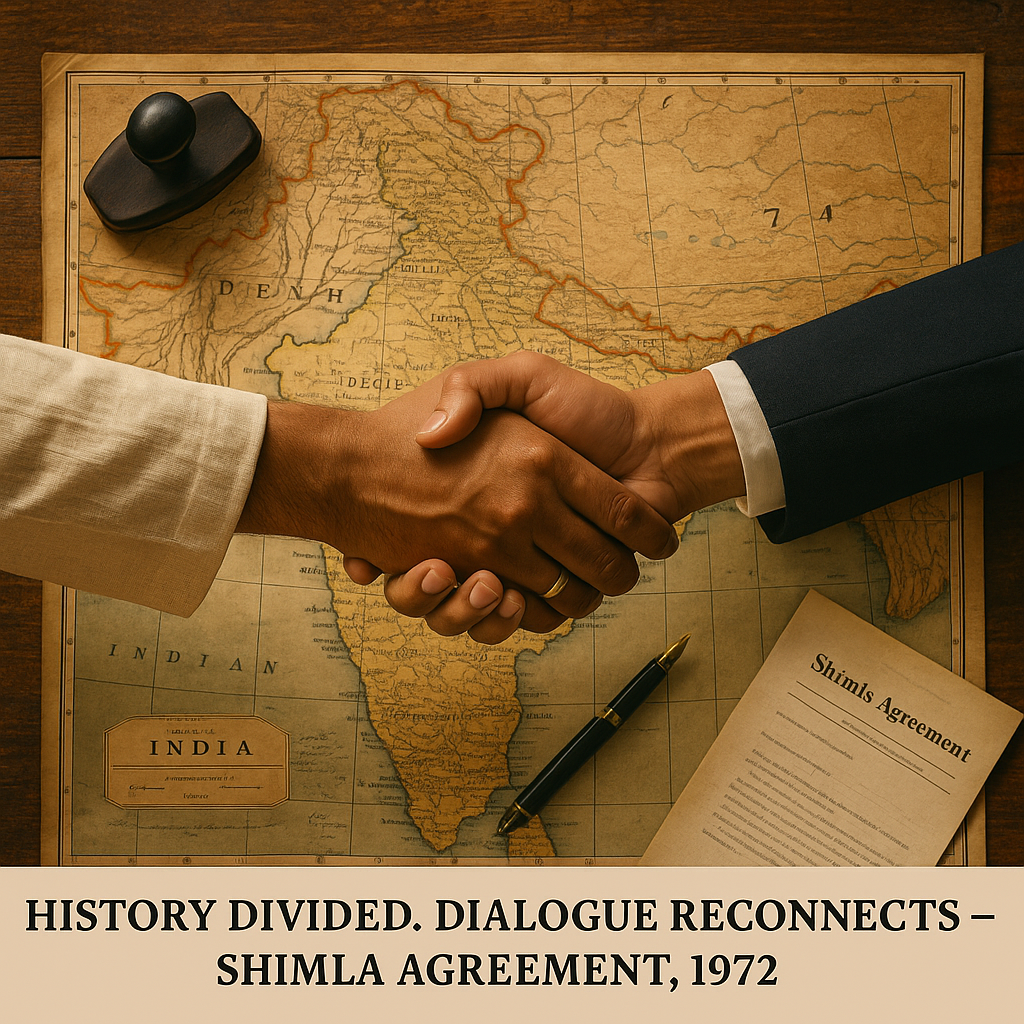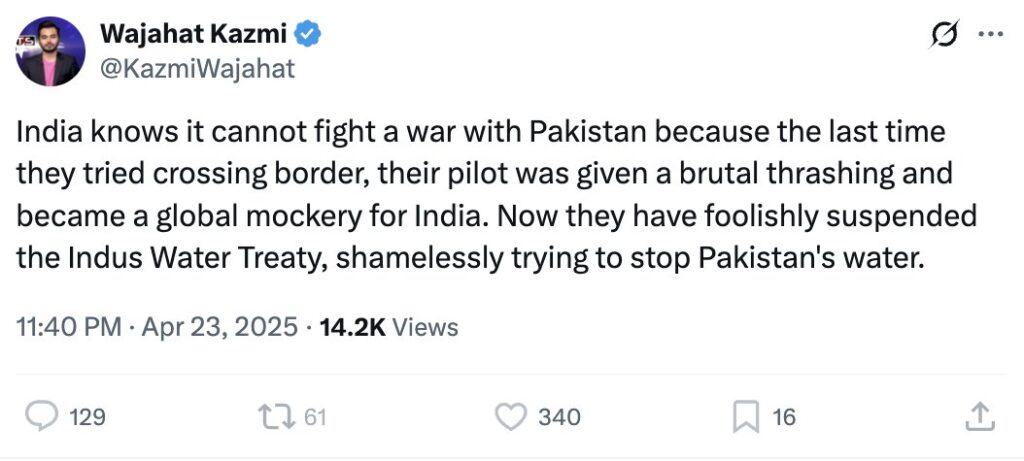The story of the Shimla Agreement is not just a tale of two countries signing a piece of paper. It is a living, evolving saga—one that began in the aftermath of war, shaped decades of uneasy peace, and now finds itself at the centre of a new and dangerous standoff. To understand its significance today, we must first meet the characters and voices shaping the current crisis.

Table of Contents
The Voices of Today
The latest chapter opens with a chorus of Pakistani voices on social media, echoing the anxieties and anger of a nation under pressure. Wajahat Kazmi, a prominent commentator, sets the tone with a barbed tweet:

“India knows it cannot fight a war with Pakistan because the last time they tried crossing border, their pilot was given a brutal thrashing and became a global mockery for India. Now they have foolishly suspended the Indus Water Treaty, shamelessly trying to stop Pakistan’s water.”
Kazmi’s words are more than just bravado—they reflect the raw emotion in Pakistan after India’s unprecedented move to suspend the Indus Waters Treaty (IWT) following the Pahalgam terror attack. The decision, announced after a deadly assault in Kashmir that killed 26 civilians, was India’s most forceful response yet to what it calls “cross-border terrorism”.
Ch Fawad Hussain, another influential Pakistani figure, quickly added his voice to the storm:
“India under international law cannot put Indian Basin treaty in abeyance, it will be gross violation of treaty law, this childish decision ll effect only poor farmers of Punjab and Sindh.”
His tweet highlights the humanitarian angle, warning that millions of ordinary Pakistanis—especially farmers—will suffer most from India’s decision. The message is clear: India’s move is not just a diplomatic snub, but a blow to the heart of Pakistan’s economy and society.
Then comes Brigadier Ashfaq Hassan, raising the stakes with a warning of reciprocal action:
“Pakistan also has the right to walk away from Shimla Agreement and all such other agreements at its own as a response.”
And in a longer post, he elaborates:
“Indian madness and recklessness will be responded accordingly. IWT is an internationally brokered and guaranteed treaty. Walking away has international implications, and India can not do it unilaterally. Is any other Indian international guarantee / treaty / agreement has any worth? Can India even physically implement this one sided suspension?… Rest all measures are reciprocal and will be well taken care of.”
These voices, amplified by ministers and officials across Pakistan, accuse India of “water warfare,” “reckless suspension,” and violating international law. The threat is unmistakable: if India can walk away from its commitments, so can Pakistan—including the foundational Shimla Agreement.
Act 2: The Birth of the Shimla Agreement
To understand why these threats matter, we must travel back to 1972, when the Shimla Agreement was born out of the ashes of the 1971 Indo-Pakistani War. That conflict had led to the creation of Bangladesh, the surrender of 93,000 Pakistani soldiers, and a deep humiliation for Pakistan. Both nations stood at a crossroads—India, the victor, sought to stabilize the region and avoid further conflict; Pakistan, the vanquished, hoped to regain its prisoners and salvage its dignity.
The Shimla Agreement, signed by Indian Prime Minister Indira Gandhi and Pakistani President Zulfiqar Ali Bhutto, was a bold attempt at a new beginning. Its key provisions included:
- Bilateral Resolution of Disputes: Both sides agreed to settle all issues, including Kashmir, through direct talks, not international mediation.
- Line of Control: The ceasefire line in Jammu and Kashmir was redefined as the Line of Control (LoC), with both sides pledging not to alter it unilaterally.
- Normalization: Commitments to restore diplomatic, economic, and cultural ties, and to respect each other’s sovereignty.
- Release of Prisoners: India agreed to release the Pakistani soldiers captured in the war.
The spirit of Shimla was one of hope, but also of hard-nosed realism. India wanted to lock Pakistan into a bilateral process, keeping outside powers at bay. Pakistan, though weakened, saw the agreement as a way to recover its men and keep the Kashmir issue alive, albeit within a new framework.
Act 3: The Agreement Tested
Over the decades, the Shimla Agreement has been both shield and sword in the diplomatic battles between India and Pakistan. It has survived wars, border skirmishes, and countless rounds of talks. India has repeatedly invoked Shimla to block international mediation on Kashmir, insisting that all issues must be settled directly between the two countries.
But the agreement has also been tested, and sometimes strained to breaking point. The Siachen conflict of 1984, the Kargil War of 1999, and persistent cross-border terrorism have all challenged the spirit and the letter of Shimla. Yet, even in the darkest times, the agreement has provided a reference point—a diplomatic safety net that both sides have hesitated to tear up completely.
Act 4: Crisis in 2025—A New Challenge
The current crisis is perhaps the gravest test yet. India’s suspension of the Indus Waters Treaty, a pact that had survived four wars and decades of hostility, marks a new level of escalation. The move came after the Pahalgam attack, with India’s Foreign Secretary Vikram Misri declaring,
“The Indus Waters Treaty of 1960 will be held in abeyance with immediate effect, until Pakistan credibly and irrevocably abjures its support for cross-border terrorism.”
Pakistan’s response has been swift and furious. Ministers have called India’s action “cowardly,” “immature,” and “illegal,” vowing to defend every drop of water “legally, politically, and globally”. Some, like Brigadier Ashfaq Hassan, have openly threatened to walk away from the Shimla Agreement, raising the specter of a return to open confrontation.
The stakes are enormous. The Indus system is Pakistan’s lifeline, with 80% of its farmland dependent on these waters. The Shimla Agreement, meanwhile, is the last remaining framework keeping the two nuclear-armed neighbours talking instead of fighting.
Act 5: What If Pakistan Cancels the Shimla Agreement?
The question now haunting diplomats and citizens alike is: what if Pakistan cancels the Shimla Agreement?
If Pakistan were to walk away, the consequences would be profound:
- Internationalization of Kashmir: The bilateral framework would collapse, opening the door for third-party intervention—something India has fiercely resisted for decades.
- LoC in Jeopardy: The Line of Control could revert to a ceasefire line, with increased risk of cross-border movement and military clashes.
- Diplomatic Breakdown: Without Shimla, there would be no agreed mechanism for dialogue, making future crises even harder to contain.
- Escalation Risk: The absence of diplomatic guardrails could lead to more frequent and intense confrontations, with unpredictable consequences for regional stability.
Why India Has the Upper Edge
Despite the heated rhetoric and threats from Pakistan, India currently holds a significant upper hand in this confrontation. By suspending the Indus Waters Treaty, India is leveraging its upstream control over vital water resources, directly impacting Pakistan’s agriculture-dependent economy, which relies on the Indus system for 80% of its irrigation. India’s robust global alliances and its narrative of acting against cross-border terrorism have garnered international understanding, if not outright support, while Pakistan remains under scrutiny for its alleged links to militant groups. Furthermore, India’s economic and military capabilities far surpass those of Pakistan, and its internal stability contrasts with Pakistan’s ongoing political and economic crises. This combination of strategic, economic, and diplomatic strengths allows India to dictate the terms of engagement and maintain the initiative, reinforcing its position of advantage in the ongoing standoff.

Conclusion: The Road Ahead
The Shimla Agreement was born out of war, shaped by hope, and tested by decades of rivalry. Today, it stands at a crossroads. The voices on social media—Kazmi’s defiance, Hussain’s legal warnings, Hassan’s threats—are not just noise; they are signals of a deeper crisis that could reshape South Asia’s future.
If Pakistan cancels the Shimla Agreement, the region could enter a new era of uncertainty and risk. Yet, as the story stands today, India’s strategic position remains strong, its actions calculated, and its message clear: peace is possible, but not at the cost of national security. The next moves, on both sides, will determine whether the Shimla Agreement remains a living document or becomes a relic of a more hopeful past.
[…] of the Indus Waters Treaty and hinting at further diplomatic fallout. Wajahat Kazmi tweeted, “India knows it cannot fight a war with Pakistan because the last time they tried crossing border,…. Ch Fawad Hussain argued that India’s move is a “gross violation of treaty law” and warned […]
[…] in 1972 after the Indo-Pakistani War, the Shimla Agreement committed both countries to resolve disputes bilaterally and respect the Line of Control in Jammu […]